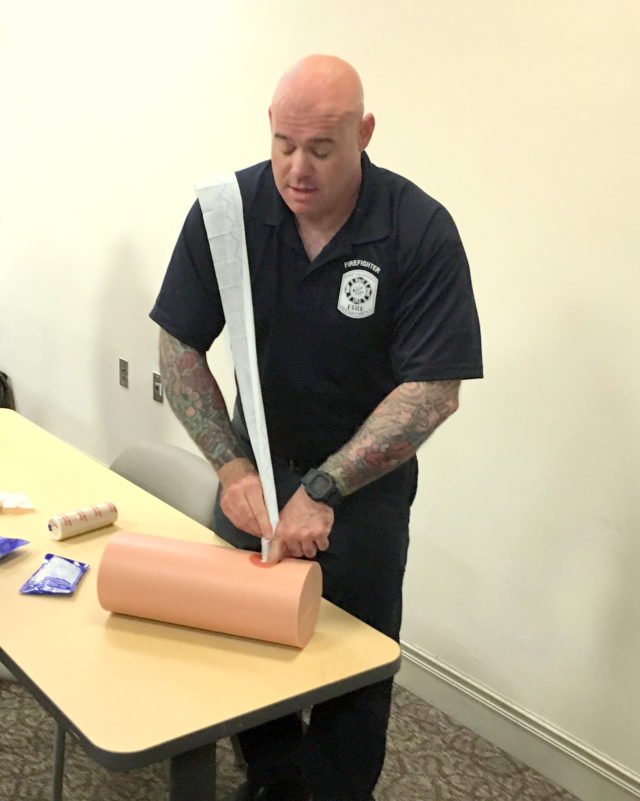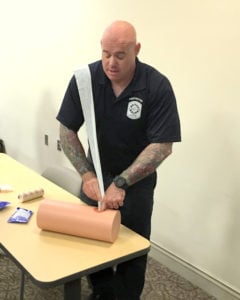

Special to SouthFloridaReporter.com
“Stop the Bleed” training is a lifesaving reality check. You learn how to use tourniquets, pack wounds, and take other critical steps in the moments following a traumatic event, before rescue crews and police arrive. It’s a practical response to the reality of modern life, which is increasingly interrupted by mass shootings, bombings, knife attacks and injuries at home, the workplace or beyond.
The American College of Surgeons estimates as many as 120,000 Americans have taken part in a Stop the Bleed training course. The organization first advocated training the public in bleeding control techniques in 2013, following the tragic shooting at Sandy Hook Elementary School in Newtown, Conn.
Course participants learn the ABCs of bleeding control, including “A” to be alert and call 9-1-1, “B” to find the bleeding injury and “C” to compress it. In small groups, with hands-on instruction from Broward Health and Fort Lauderdale Fire Rescue professionals, course participants learn distinctions between arm and leg bleeding injuries and ‘torso junctional wounds” at the neck, shoulder or groin. They differ from chest and abdominal injuries, which may have bleeding that cannot be stopped until a victim reaches the hospital.
The Stop the Bleeding Coalition includes multiple public service organizations and government agencies, with strong support from healthcare systems. Coalition research points to the fact that 35 percent of pre-hospital deaths from mass casualty events are the result of blood loss, and many of these deaths are preventable.

“We have 60 minutes to save someone’s life; it’s called the golden hour,” said Igor Nichiporenko, M.D., medical director of trauma services at Broward Health North. “If we teach a regular, non-medical person how to stop the bleed, we can save a lot of lives.”
Nichiporenko treated many of the Marjory Stoneman Douglas shooting victims and said Stop the Bleed tools and techniques employed by first responders in Parkland helped to save many lives.
“As we continue our recovery from the Marjory Stoneman Douglas High School tragedy, Broward Health is proud to be part of the Stop the Bleed Campaign,” said Broward Health President/CEO Beverly Capasso. “As a former trauma nurse, I can attest that tourniquet training is an invaluable skill for everyone. It can be used for a mass casualty incident or singular injury, such as in an emergency at home or on a playground.”
 The next Stop the Bleed training is scheduled for 12:30 p.m. on Wednesday, April 25, in the Atrium Conference Room at Broward Health Medical Center, 1400 S. Andrews Ave., Fort Lauderdale. Admission is free and registration is required.
The next Stop the Bleed training is scheduled for 12:30 p.m. on Wednesday, April 25, in the Atrium Conference Room at Broward Health Medical Center, 1400 S. Andrews Ave., Fort Lauderdale. Admission is free and registration is required.
.
If you would like to host a Stop the Bleed training event at your community function, contact Jami Rothenburg, a Broward Health trauma outreach coordinator, at 954-468-8935 or jrothenburg@browardhealth.org.












